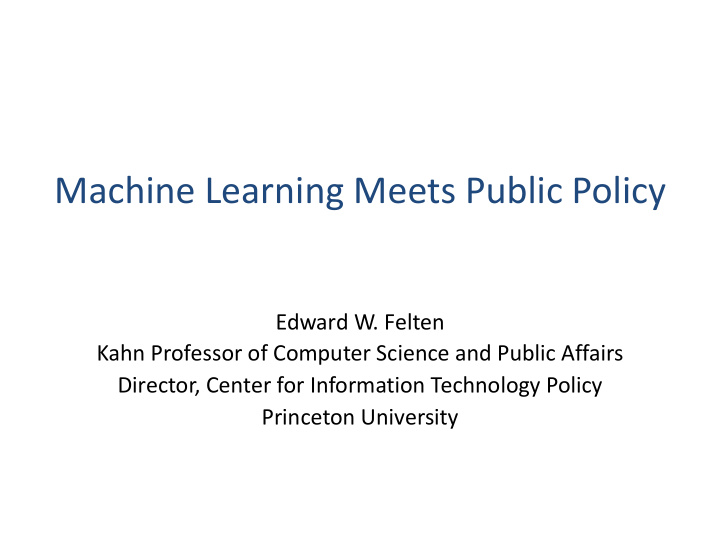



Machine Learning Meets Public Policy Edward W. Felten Kahn Professor of Computer Science and Public Affairs Director, Center for Information Technology Policy Princeton University
"AI is probably the most important thing humanity has ever worked on. I think of it as something more profound than electricity or fire.” Sundar Pichai, Google CEO 24 Jan 2018 7
People who are affected by AI/ML deserve some say in how it is used.
Decisions will be made. What is our role in the decisions?
Truth
Truth
Politics is not a search for truth.
a feature, not a bug
Democracy is not a search for truth.
an algorithm for resolving disagreements
no question is undecidable
all questions are decidable in O(1) time
no need to decide underlying facts
no need for a coherent explanation
and yet …
individual legislators seem
individual legislators seem logically inconsistent
individual legislators seem logically inconsistent indifferent to truth
Politicians behave that way for a reason.
Consider the following model …
P = universe of proposals = {p 0 , p 1 , p 2 , …} Assume proposals are independent. A bill is a subset of P.
Voter i has utility function U i (.) Voter v i supports proposal p j iff U i (p j ) > 0 Define: p j passes iff majority of voters support p j
Assumption: Given two disjoint bills B 1 , B 2 : U i (B 1 U B 2 ) = U i (B 1 ) + U i (B 2 )
Corollary: Given two disjoint bills B 1 , B 2 : If V i supports B 1 and V i supports B 2 , Then V i supports B 1 U B 2
Theorem: Given two disjoint bills B 1 , B 2 : If B 1 passes and B 2 passes, Then B 1 U B 2 passes
Non- Theorem: Given two disjoint bills B 1 , B 2 : If B 1 passes and B 2 passes, Then B 1 U B 2 passes
B 1 B 2 B 1 U B 2 Voter Alice 1 -2 -1 Bob -2 1 -1 Charlie 1 1 2
outputs not logically consistent
Let’s generalize the model …
partition voters into districts
partition voters into districts legislature: one rep per district
partition voters into districts legislature: one rep per district rep supports B iff majority of constituents support B
implications
legislator not logically consistent
legislator not logically consistent supports B 1 , supports B 2
legislator not logically consistent supports B 1 , supports B 2 might not support B 1 U B 2
legislator doesn’t care about the facts
individual legislators seem logically inconsistent indifferent to truth
legislative strategy
Consider the following problem…
Amendment Problem Given: bill B amendments A 1 , …, A n (mutually disjoint) Can you add a subset of the A i to B, to make an amended proposal that will pass?
Amendment Problem NP-complete! Given: bill B amendments A 1 , …, A n (mutually disjoint) Can you add a subset of the A i to B, to make an amended proposal that will pass?
Nobody knew this could be so complicated. Ted Stevens
real world: even more complicated
voters not self-consistent
legislators make deals
administrative agencies
indirectly accountable to voters
locally, system will look irrational
It’s complicated.
what to do?
“It’s not okay to not know how the Internet works.”
“It’s not okay to not know how government works.”
good decisions
just the facts
dictate the decision
Who elected you?
download your brain
be useful
your knowledge + their preferences
your knowledge + their knowledge and preferences
get their knowledge and preferences structure the decision space
Knowledge Knowledge Preferences
engagement over time mutual trust
role of our community
need boots on the ground
create a career path
build incentives
This is important!
We need to be in the room.
Machine Learning Meets Public Policy Edward W. Felten Kahn Professor of Computer Science and Public Affairs Director, Center for Information Technology Policy Princeton University
Recommend
More recommend